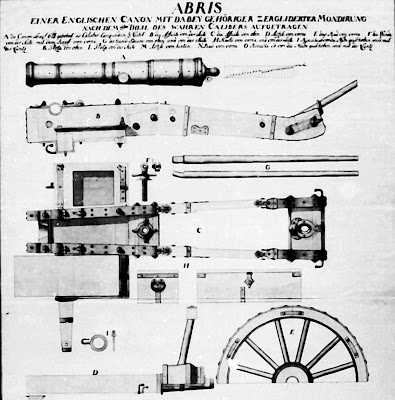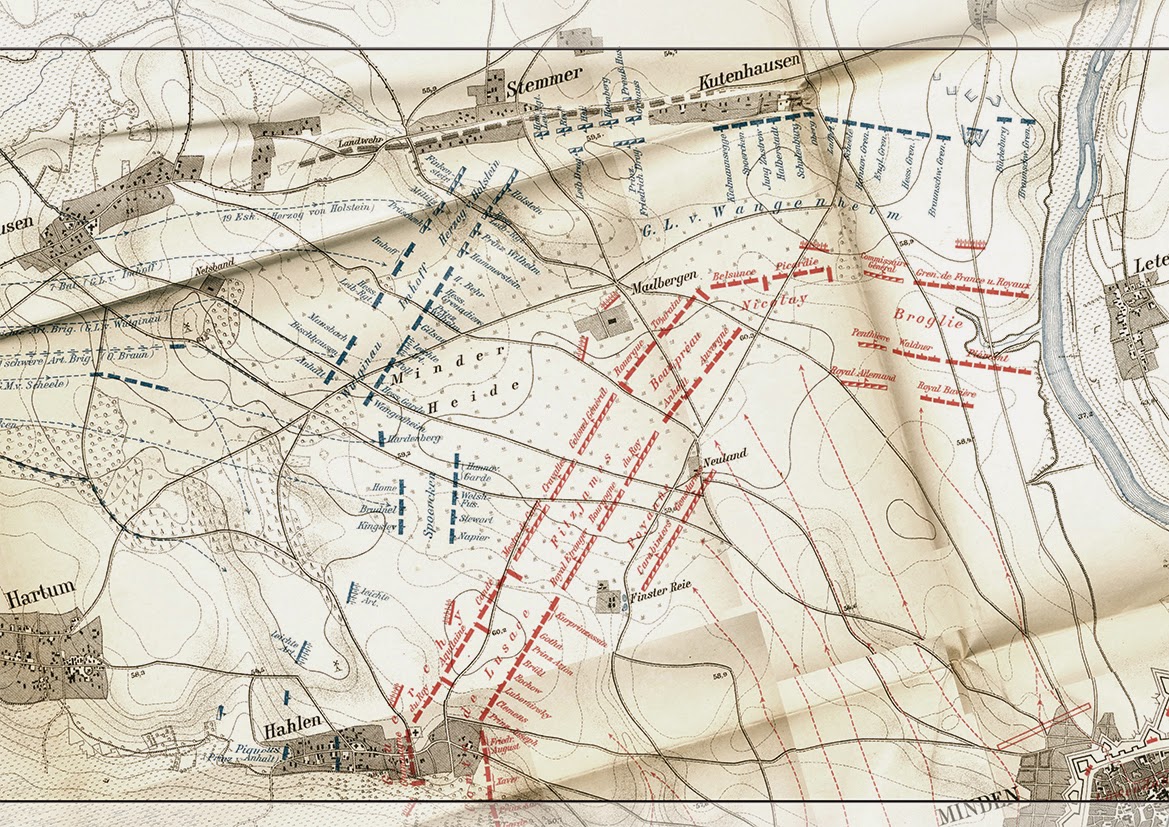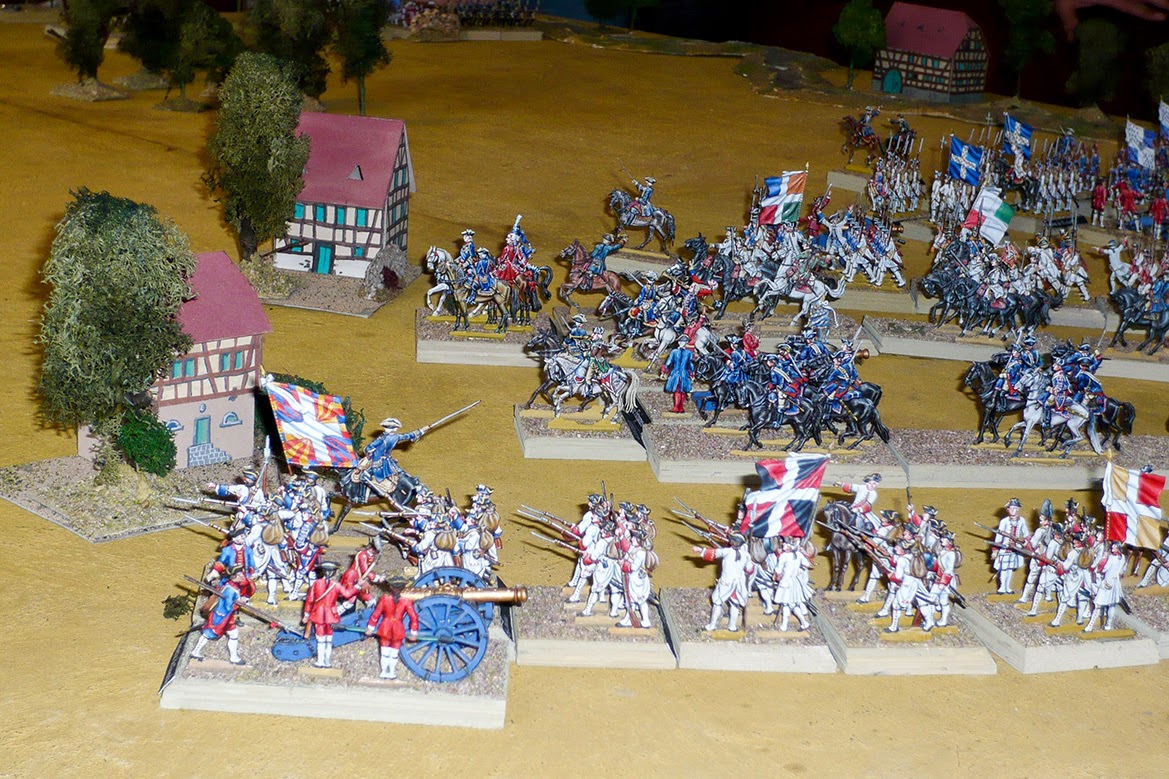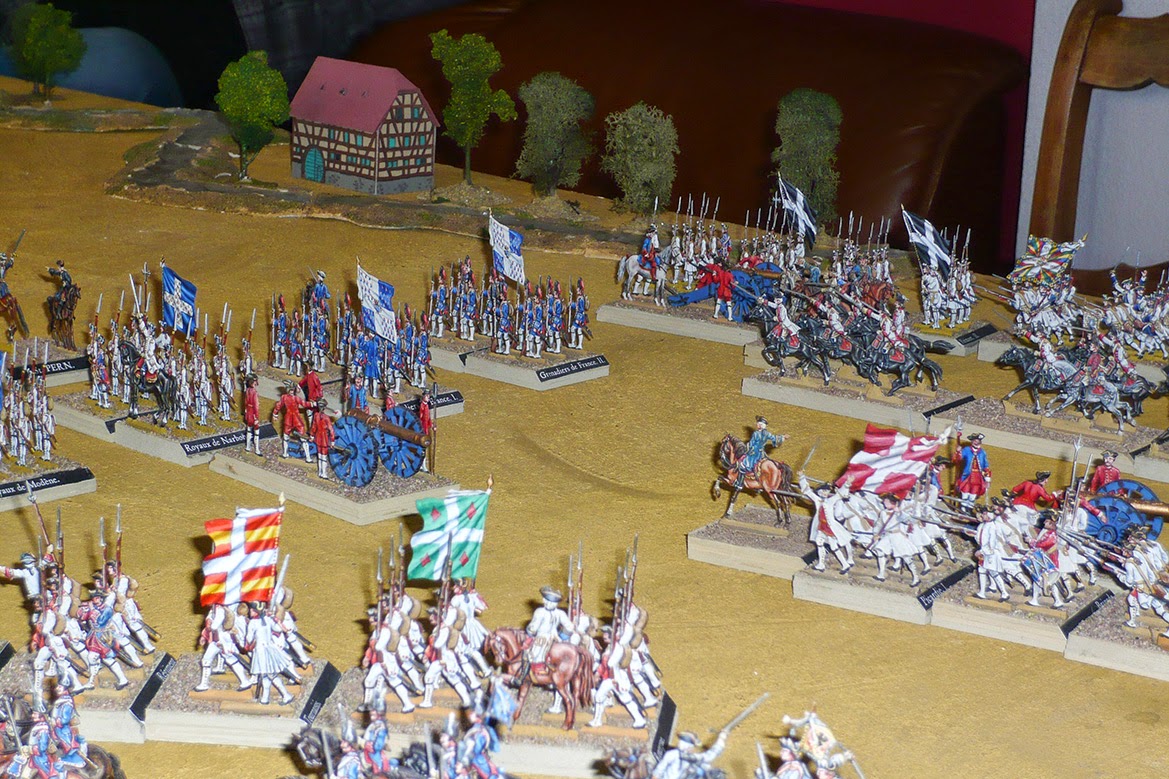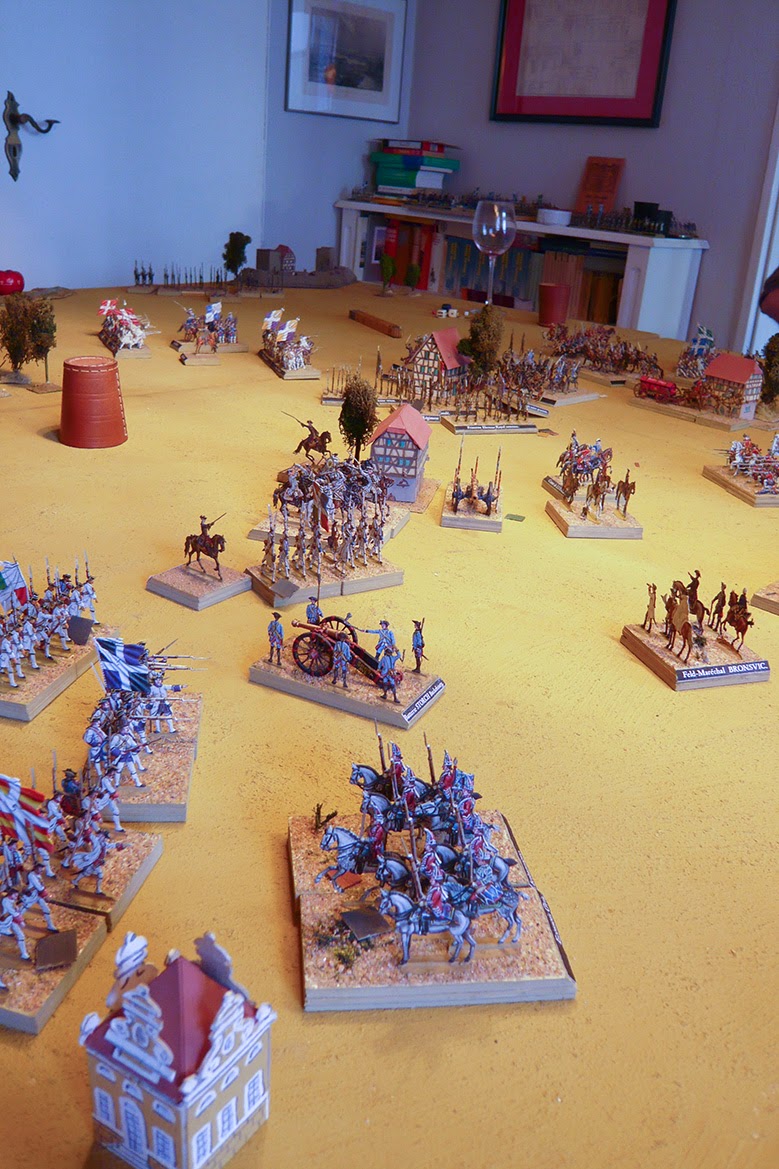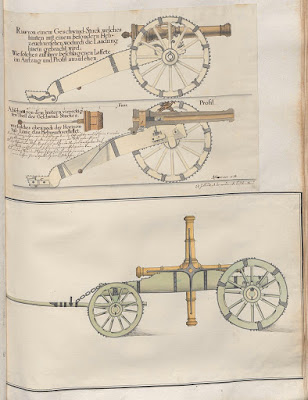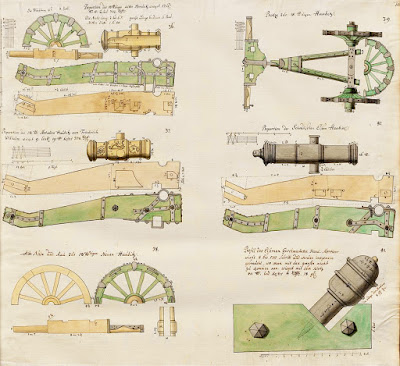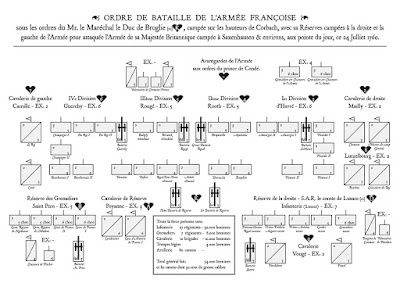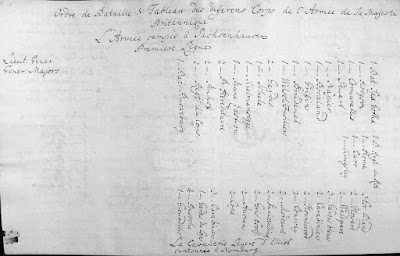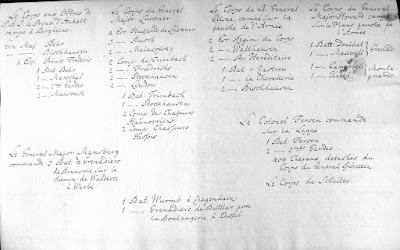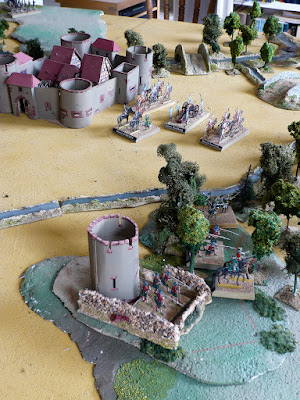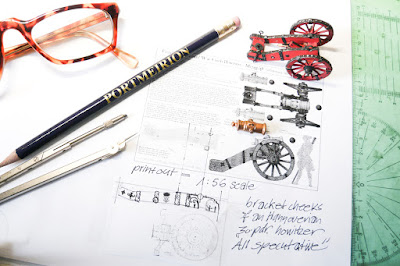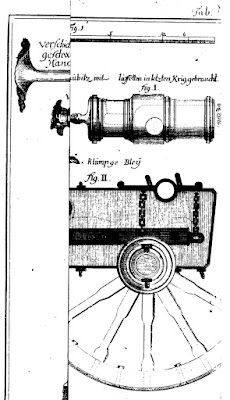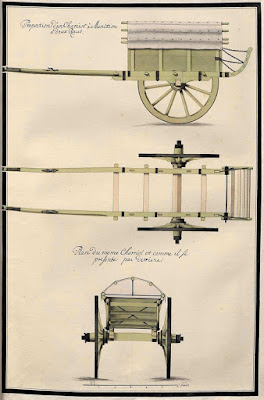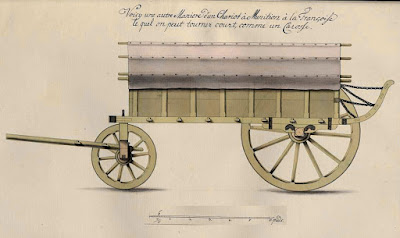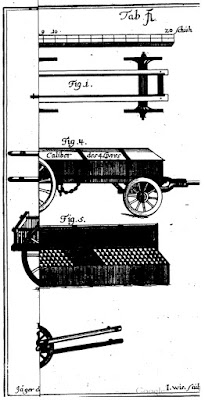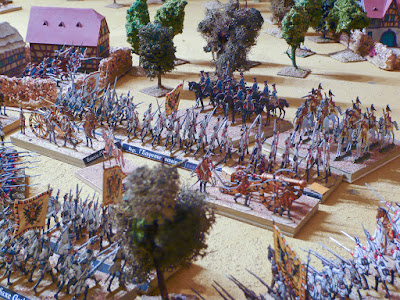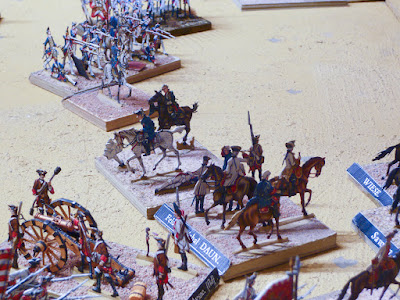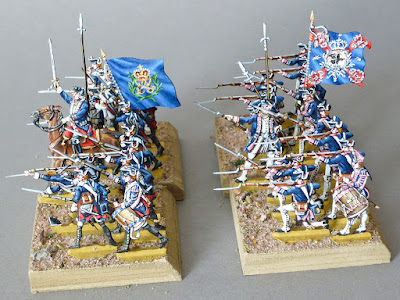With the below, I found it worthwile to share an extract from the German language original: Hessische Chroniken, vol. I: „Die Isthaer Chronik des Pfarrers Johann Georg Fülling. Zur Geschichte Niederhessens im siebenjährigen Kriege“ [“The Istha Chronicle of vicar Johann Georg Fülling. History of Lower Hesse during the Seven Years War”], publ. by Gerhard Bätzing, Kassel 1957. (Istha village – approx 1 mile to the south of Wolfhagen).I started to translate Füllings chronicle of the year of 1760 to make it available also to an English reading audience. I believe the information that can be extracted from his rather detailed observations are highly interesting. He starts off with the preperations and the beginning of the campaign. The more distant the war takes place, the more of his information is based on rumor and hearsay, but the closer it comes, the more detailed it is. His community is about a days march due West from Kassel. The war arrived near his countship at July 10, with the action of Korbach and saw its culmination with the two armies passing and encamping in his village July 25-30.
Well have a read yourself, if you like. It all adds so well to my ongoing 1760 Campaign ‘near battles’ project. Record of the local occurrences in 1760
Now, I will get to the chronicle of a year, which, owing to the suffered misfortunes, will remain unforgettable to this community. A year, we were to face war, and most of his terrible consequences, in which especially this community sustained a loss, I believe, we won’t get over with in years. Our misery was even more unbearable, for it took us by surprise, against all hopes, all likelihood, and expectation. We had been in the hands of the Allies. Since past years August, they had swept off the French from this country, which had partly withdrawn across the Rhine, and the Allies than kept this province occupied. The Army had been significantly increased and it was hoped, that it would keep the French away from our borders, as they had been beaten the other year. Kassel had been fortified, and work on the defences endured from winter throughout spring, at all efforts and extraordinary costs.
May
With the beginning of May a small corps commanded by general Imhoff took its camp near Kirchhain on the Ohm. The Grand Army assembled near Fritzlar. May 20, Prince Ferdinand took his headquarter in Wabern, the main camp rested from Fritzlar to Kappel, the Highlanders encamped on the ‘Uhlenborn’ heath. The English headquarter was in Fritzlar, and that of the Erbprinz in Möllrich. Many new regiments from England arrived, which approached via Paderborn and Wolfhagen. The camp rested unaltered throughout this month.
June
June 6, the Erbprinz departed with a small corps, and marched to Schlitz, where general Gilsa had been in position for some time. Finally, June 23, the whole army marched off, and took its first camp near Frielendorf and Treysa. The field bakery in Fritzlar had also advanced. June 27,we were in for the first shock, for it was said, the Army is retiring, and the bakery and baggage train had returned to Fritzlar. Shortly later, it was said the Grand Army still kept its camp near Ziegenhain, but the Erbprinz had to conduct a hasty withdrawal from Schlitz to Homberg, and general Imhoff had been forced out of his position near Marburg with heavy loss, and had now joined the Grand Army [the chronology of events has been somewhat confused here, as it was all based on hearsay]. To all those controversial news, the French apparently had captured Amöneburg and Marburg, and Prince Ferdinand now had his headquarter in Michaelsberg, and the Erbprinz headquarter was in Obergrenzbach. It augured badly, as many heavy guns and ammunition were send back to Kassel.
July
Afternoon, July 1, it was said the French were in Ippinghausen. A horrid mystery to us it was. The next day it was said, about 500 light troops had arrived at Züschen by dawn, captured eleven of general Granby’s own horses, and thereafter advanced to Fritzlar. Here, in haste, they had looted general-commissioner Massow’s baggage train, nailed a number of guns, captured some English baggage along the main road, poured out the flour of 40 flour wagons, and made off with all horses. Without doubt, they had been informed of the approach of a small corps under general Luckner. The French took the route via Züschen and Numburg, here they demanded for beer and brandy, in Ippinghausen a number of men absconded and engaged into marauding. 20 Allied hussars made after them, while Luckner took his way via Bergheim in order to cut their retreat. A detachment met the French near Freihagen, engaged in a skirmish, killing many and taking some 60 men prisoner along with a number of horses. For a while now, all was quiet. Then, Wednesday July 9, it was said the whole French Army had left its camp at Neustadt and Speckswinkel by night, and is now advancing on Korbach; while at the same time Luckners hussars and the Erbprinz corps are advancing to Sachsenhausen, followed by the Grand Army. Thursday July 10, one could hear a violent cannonade. It lasted till 2 in the afternoon. You could not only hear the guns, but also the small arms fire. So intense was the fire, that one would have believed it to be the noise of a major battle [This was the clash of the French and Allies combined Avantgardes at Korbach]. Our fears were great, and we all hoped the Allies would remain victorious. The same evening, I was informed by his most admirable provost Köhler from Wolfhagen, of the Erbprinz engaging with only some 12 regiments with about 40 thousand Frenchmen. Initially they had been beaten off, but finally he had to leave the field to the French, leaving some 7 guns, after suffering great damage from their guns. This news was confirmed the other day, and our casualties were said to be not more than 800 men. The same day as the action occurred, it was said, the Grand Army had arrived at Höringhausen, though, taking its camp without tents. The same day, a detachment of hussars occupied Wolfhagen and secured the towns gates. Both armies now opposed another; the French encamping in Korbach, and the Allies in Sachsenhausen, where Prince Ferdinand’s headquarter was set up, whereas the English’s was established at Höringshausen. Sunday July 13, general Spörcken’s corps of about 18 thousand men, that had been resting in the Münsterlands, now had arrived at Landau, Spörcken took his headquarter in Stadtberg on the Diemel [now Marsberg] the other night, after forcing out the troops of count St. Germain from this town. Now the Allies would hold the line along Volkmarsen–Stadtberg [Marsberg]–and Landau. July 15, Spörcken marched from Landau to Billingen, and on July 17, to Lutzen. On this day it was said, the French had occupied Mengeringshausen and Arolsen. July 18, it was heard the Erbprinz had ruined a French corps of about 6.000 men in a surprise attack encamped near Speckswinkel [This was the Action of Emsdorf]. 6 guns, and all of their baggage had been captured, and three generals were made prisoners, the prince of Anhalt-Köthen among them. July 20, it was heard the Erbprinz had captured 600 French oxen at Halsdorf and Luckners corps had ruined some 7,200 sacks of flour in Marburg, and captured a lot of baggage. July 21,60 centners of hay were foraged by the Hannoveran regiment of Waldhausen in our village. July 22, English cavalry and artillery servants foraged. They receipted one forage unit of 25 rations with 10 pounds per ration. The total amount of hay that had been foraged on receipt within two days was 566 'centner' [hundredweight]. Wednesday, July 23, the foraging intensified. Countless parties kept coming in – a many of them went off without paying. The English had guarding patrols to keep their foraging parties from engaging in 'desordres'. My hay was not foraged, and I thought I was lucky. But to my sorrow, I would loose all of it within the next days by English and French billetings, without receiving a penny for it. The others could at least hope for a return sometime in the future. We would have been lucky if it was only the hay we were to loose. But, even worse, the fields abloom, of which even the old people could not recall of ever seeing such a blessing before, were to be completely ravaged within the next few days. And thats the story:
Thursday, July 24, one could hear a most dreadful cannonade on the Allies right wing near Volkmarsen. You could see all discharges of the cannons from on top the Isthaberg. At about 11 in the morning it was heard in great fear, general Spörcken’s baggage train was marching right through the Wolfhagen fields. It seemed to settle at the 'Gotzenberg', but soon later it continued its march, and eventually passed through our community. Our fears grew, as we saw the Grand Army’s baggage approaching towards us. We saw the bakery wagons carrying raw dough. We took this as a sign for the Allies retreat. A number of officiers reassured us, that the baggage train had marched off without orders and would soon after return. At 2 in the afternoon the cannonade ended, and it was said the French had captured a battery. The same day we were informed of the Allies right wing being forced into withdrawal, and the French having occupied Ehringen and Viesebeck. Fischer’s men had plundered Breuna’s bailiff Faber and vicar Coester, and patrolled as far as Nothfelden. Friday, July 25, the cannonading continued, while the passage of the baggage still endured. At 8 in the morning we learned of the English headquarter to be set up in our community. Many English soldiers were marauding poultry, hog, and raked the peoples chests, until, on my request, a German officer send a Brunswick detachment to care for our security. The right wing now rested at the Isthaberg quite near the so entitled 'Donnerschlag', and stretched towards Altenstädt. English artillery was deployed near the 'Billstein', and a number of regiments formed up on the Istha fields. The Allies ravaged the surrounding fields as much as they could. The small prayers house on our graveyard along with the benches, which had been left untouched by the French Legion Royale Anno 1758, was now torn apart and burned up. Mylord Granby had his lodging in the vicarage.
The 4th French Invasion
On Saturday, July 26, Mylord Granby called for me and informed me in French, the Army will leave at around 9 in the morning. He proposed to send my valuables to Kassel. My wagon was to join his personal convoy, and with his passport, should travel forth and back unharmed. How terrible a proposal, with regard to my present condition! I was lacking the means to arrange for all within such a short span of time. I would not get a transport, even at the price of 100 Reichsthalers cartage for the way to Kassel. All horses had been taken away by our folks and were now hidden in the surrounding woods. One can imagine my feelings. The many men’s and wagons turmoil of the departing army lasted till about 1. By this time, a column of the Arriergarde, commanded by the Erbprinz, passed this village. You could now hear the cannonading coming closer. Continuously it was asked for bread, milk and other victuals. The Highlanders were the last to pass the Lower Lane and formed up on the 'Kampe', and than headed for the Isthaberg, where they deployed within the hedges. From my upper chambers window one could observe several bodies of French closing in on the hidden Highlanders and exchanging fire. All during this time, it was dead quite in the village. All inhabitants were hiding. This silence was the more fearsome, as it was succeeded by a horrible turmoil. This silence lasted about half an hour, till one could hear the clatter of a single horse. It was a French Schomberg dragoon, and, with a pistol in his hand, crying out for me and asking for money. I gave him 1 silver Thaler. Soon he returned, accompanied by 2 more dragoons and a Fischer hussar and now they all asked for ham. My wife gave them one. Now, all got off their horses, drew sabres and entered into the house. My wife had to unlock the pantry. They took two chicken, game, along with some bread, sausage and butter. The Fischer pulled my golden watch out of my pocket and made off. After complaining to another Schomberg dragoon, he made after him. Shortly later, a whole piquet of these dragoons appeared. I addressed the officer, asking him for a 'sauvegarde', which he instantly conceded to me. He ordered one dragoon to stay with me. The officer, who happened to be the count of Custine [believed to be no other than Adam Philippe, Comte de Custine,*1740–†1793], told me of having heard of my stolen watch, and assured me that it would be returned soon. The Fischer returned the watch with the counts pistol pointed at his head. Thereafter the Fischer made off. The 'sauvegarde' kept me from suffering great harm. My house would have otherwise been completely plundered. Many hussars appeared in front of the vicarage, which he held off with great bravery. Until the quarterings would move in 2 hours later, he remained in front of the door, which I had to lock. While talking to this certain officer, I mentioned above, a single discharge was heard at the other end of the village. The whole piquet now rushed to this direction and exchanged fire with a squad of Allied hussars, of which a Brunswicker was left badly wounded. He died here. I saw him shortly before his passing away. He was the certain Mr. von Bernsdorf, a native from Waldeck. In the evening, there came two officiers of the regiment Royal Bavière. One carrying a linen sack, the other with a soldier with him, they were very polite, talked German, and told me that they had caught this marodeur in the mayors house, and that he was to be hanged the next day. They left the marodeur with my 'sauvegarde', and the mostly emptied sack to me, in order to keep it for the mayor. As they were about to make 'billets', orders came in, that Prince Robecq with his Volontaires, and a command of Swiss soldiers were to take their quarters here. Prince Robecq had his lodging in the vicarage. As he did not have his kitchen wagon with him, my wife had to cook for him. His aide-de-camp told me that I was to inform the village’s inhabitants, that they ought not give anything to the soldiers. If anybody was to be harmed, one should not hesitate informing him. Later than, as folks did inform him, he instantly went with them, and arranged for an end of their troubles. The Princes 'mâitre-d’hotel' also was a very gentile and agreeable man. In the evening, an officer asked for me, and as I got out, he embraced me like a brother. At once, I recognized him as the certain lieutenant-colonel d’Armetrout, who I mentioned on page 74 [of the manuscript – a protestant Swiss, who had been quartered in the vicars house the previous year]. The affable conduct of the French, and the fine order they kept, made us forget that we were in the hands of our enemies. Our hearts – so full of fear – in expectation of our unsure faith, had now become easier. It had been a great relieve, I had not been plundered – with exception of the victuals mentioned above. My neighbour got it worse. Vicar Lahusen from Altenhasungen, had been completely plundered, as he was hiding in the nearby woods. His loss amounted to about 500 Reichsthalers, to his own specification. Old vicar Rassmann from Balhorn, albeit staying in his house, had the same fate. He lost all of what had not been dissembled, along with 30 Reichsthalers, and suffered a wound from a bayonet thrust in his arm. The bailiff of Merxhausen had to endure violent looting, as they knocked in his door and broke his windows. Our community was speared from 'hot' looting, but more severe was the rape of livestock. Most of the communities inhabitants had spend several days hiding at the Isthaberg, with all our horses. As the Highlanders took their position on the Isthaberg, and in the event, had been attacked by the Fischer Corps, our folks were now found in real danger. They all ducked to the ground in order to escape the bullets sniping through the hedges. Soon later, the Fischer took notice of them, and not only took their money, but also forcibly depredated them of their shoes, clothes, and 40 horses, not including the many Brüdersen villages horses. Sunday, July 27, lieutenant-colonel Armetrout informed me of the Army's headquarters to be set up here. As I now told him of my many belongings, that I had hidden in the church, he asked me to carry all out, as the church was to become the location for the prisoners. Just after we took our belongings out, I had to hand over the key to the 'Grand-Provost'.
![]() |
Copyright restricted image – It is published here for purely academic use without any commercial intention. © 2014 DigAM - digitales archiv marburg / Hessisches Staatsarchiv Marburg |
Maréchal Broglie arrived in the evening, while his baggage had already arrived at noon. I was left to stay in my houses parlour and chamber, where all furniture was moved. A cousin of the Duc de Broglie [his brother, the comte de Broglie?], along with a number of officiers had their lodging in my loft. My house was found so crowded that, at times you could not enter the stairway nor open the doors. The streets were found jammed with people. Outside the village a regular market stretched from the 'Pfarrbleich' farmstead into the fields. All of the fields were filled with tent rows. One Corps encamped from near the 'Hagen' all the way to the 'Läusebügel'. The main columns camp stretched from the Isthaberg across the vicarage fields, the Gehren fields, and out to the 'Hagen'. The Avantgarde encamped on the 'Rhöde' and 'Schotter' fields. The right wing aligned into the direction of Balhorn and the left wing rested near Weinigenhasungen. The French and Swiss Gardes were encamped near the 'Burgholz' and had also occupied the Burghasungen hill. Hussars were lodging in Ehlen and in Burghasungen, where Prince Robeq with his Volontaires had now been quartered. The Army remained in this position until July 30.During the time the French headquarters was located in our community, its inhabitants sold most of its remaining draught animals at rather low price. Some sensed they would be taken away from them, anyway, others thought that by this way they would be relieved from the forced transports and could rather stay at home. But most people really sold them because they realized they would not have the means to feed them anymore, now that the entire harvest was lost. Within only 4 days our community sank into poverty. All of our fields and all the vegetables had been completely eaten up or devastated. During all this turmoil and commotion, we hardly worried about the harvest. It wasn't our most pressing concern. The want of water caused so much more misery. All fountains had been found emptied in rather short time. The soldiers and sutlers even used the horse troughs water, despite it being mostly dung. Water carriers toured the camp selling a pint for about 8 Heller [or 4 pennies]. For the Maréchals kitchen, water was brought on wagons from elsewhere. At that time I still owned 13 cattle. They suffered from severe thirst as you were allowed to enter the stalls only very early in the morning. A sentry was placed next to my hay and you had to ask for permission from the Maréchals Master of Household to take any to feed my cattle. Nevertheless, the Maréchals cooks demanded 12 measures of milk each day. My water needed for cooking had to be fetched from far distant at daybreak and needed filtering before it could be used. Our old small stove in the small chamber was now of good service to us as it became our improvised kitchen for the next days. [Content somewhat condensed] All during this time countless officiers entered the house, a many serving as the Maréchal's aide-de-camps, writing letters in my big chamber, managing the many folks requests for sauvegardes, or incidents of marauding or plundering. The Maréchal maintained a splendid dining table. Our lower chamber as well as the kitchen served as the Maréchals personal confectionary. As my house was too small for his dinner table, it was placed under a tent in Faber's garden.
The Headquarters remained here for 4 days. July 30 in the afternoon at around 2, the Maréchals baggage eventually marched off, while the Maréchal himself had already left at 8 in the morning. Major Lorch, adjutant-général to the Maréchal, arranged for my sauvegarde Friedrich Trempi, a reformed Swiss from the regiment of Gardes Suisses, who I had to pay 40 French Sous a day, apart from free board and lodge. I kept him all through November 25.
The departure of the baggage lasted the entire day. I went to my fields. Oh, what a sight! All had turned into barren land. A few days before it was a pleasure garden and such a joyful sight that you just couldn’t take your eyes off. Now, with teary in the eyes you were looking at completely devastated wasteland. You couldn’t find enough for even a single bushel of hey for our communities starving cattle. Because of the intensive patrolling, it was also no option to herd the cattle into the nearby woods undetected. Finally, I was left to sell a good number of my cattle to French butchers at half price.
July 31 was all in silence. The French headquarters had moved to Dörnberg the other day. Not a single soldier was seen. Our community prepared to untie the French camp and share out what had been left over. That evening, news spread, a many troops had arrived at Landau coming from Warburg. We had no idea what it all was about. Soon later we learned that a many wounded had arrived at Wolfhagen. The mayor’s house, all the barns, and the ‘Renthof’s’ stalls were found filled. The next morning, a number of passing Swiss stragglers told us general Du Muy’s Corps had been beaten at Warburg the other day.
… The translation is to be continued





